regions:
Today in the tropics like grown mango is native to the Indian space.
 at the ends of the branches to develop the fruits (Tenerife) | |
Growth:
grows in the tropics, the mango into a large tree up to 40m high. The leaves are alternate, up to 5cm wide and up to 30cm long. The leaves are not shed in winter. Young leaves are reddish in color and relatively soft, then they are green and leathery. Torn off a leaf, smelling of turpentine it. The freshly expelled foliage is usually colored red and looks like withered.
The flowers are produced at the ends of the branches. There are large panicles with a very high number of individual flowers. This individual flowers are only a few millimeters in size and yellow-colored pink. Flowers We are formed only very rarely a result, no fruit will also be created. The mango tree is but an attractive foliage plant dar.
The flowers are produced at the ends of the branches. There are large panicles with a very high number of individual flowers. This individual flowers are only a few millimeters in size and yellow-colored pink. Flowers We are formed only very rarely a result, no fruit will also be created. The mango tree is but an attractive foliage plant dar.
| | |
location:
| summer | the mango tree you hold with us best all year in a glass house. There he receives a sunny place. Potentially, you can also put him in the summer outdoors in a sheltered and warm place. |
| Winter | Winter tell him to temperatures above 15 ° C. One should not simply the mango tree planted out in the greenhouse, because it forms a very extensive root system. This will soon be across the entire glass house and it can occur for the suppression of other plants. The best way to put it in a sufficiently large vessel, then the roots can not spread uncontrollably. |
| |  The flowers are arranged in large panicles. In the enlarged portion already fertilized flowers are visible. (Hamburg) |
cultivation / propagation:
suitable for growing the seeds of bought in the supermarket, ripe fruit. The hairy core is freed from the flesh and can then be implanted in theory. They usually germinate but rarely because they are harvested immature and too weak to split the shell. With a little trick can help out one. By making the shell of the seed with a knife splits and takes out the seed core therein. The splitting is best done by penetration of a few millimeters with a knife and then turning the knife. CAUTION Do not hurt yourself! Finally, a finger to penetrate and open the shell entirely. Sometimes You will need several attempts to get in an undamaged seedling from the shell. This is then inserted halfway into loose soil. The whole is then placed at approximately 20 to 25 ° C in the shade. By using a mini greenhouse or slipped over a plastic bag until the release of the first leaves the humidity is kept high. The first leaves appear after 3 to 4 weeks and are dyed red, rather soft and hang down slightly. Cautiously, plants can be used slowly to full sun.
expert tip from Andrew Küper
Mango Hello friends, I
has come so spontaneously with the idea to craft a mango cultivation instructions. I myself have always felt it particularly difficult to free the seeds from the hard shell. It was also always the question: Do I now remove the seeds from the nuclear plant or the whole I have a (hard) core?
My experiments have shown that the divestment is the safest method of obtaining a mango plant, but also something "figgeliensch is. (Figgeliensch "= Low German for" difficult ") The seed is easily hurt and the fingers are in imminent danger if the sharp Blade of the knife is used as a lever and is to be held in the other hand the slippery core!
have for you is why I developed a step-by-step instructions.
Mango Hello friends, I
has come so spontaneously with the idea to craft a mango cultivation instructions. I myself have always felt it particularly difficult to free the seeds from the hard shell. It was also always the question: Do I now remove the seeds from the nuclear plant or the whole I have a (hard) core?
My experiments have shown that the divestment is the safest method of obtaining a mango plant, but also something "figgeliensch is. (Figgeliensch "= Low German for" difficult ") The seed is easily hurt and the fingers are in imminent danger if the sharp Blade of the knife is used as a lever and is to be held in the other hand the slippery core!
have for you is why I developed a step-by-step instructions.
| first The cut through the mango is along the core. Mangoes have a small raised area. This "Gnubbel" should be on top. Intersects the left and right of the seed (see photo), the mango into three sections. In the middle of the hard seed kernel as shown (after removal of the pulp) | 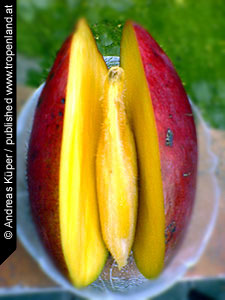 |
| 2. a previous drying of the core to minimize the risk of injury during the subsequent step. The mango has a round core and a sharp / soft end. The pinch you can penetrate into the pointed end and opened carefully with easy lever movements with the core. | 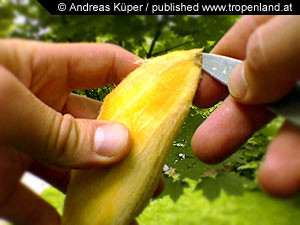 | |
| third Does the knife slowly down. PLEASE CAREFULLY! I would not be responsible for several tropical plants fill the emergency rooms of hospitals friends! | | 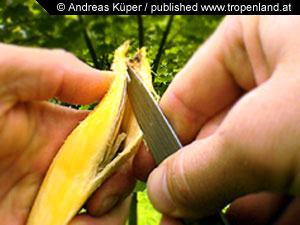 |
| 4th From now on 's harmless. Splitting the core with your fingers as shown further. | | 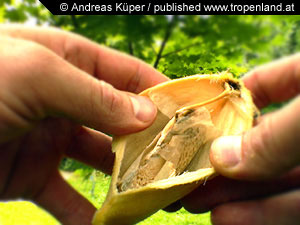 |
| 5th Now you solves the real seeds from the hard shell. The small fibrous pieces (umbilical cord?) You can carefully remove. | | 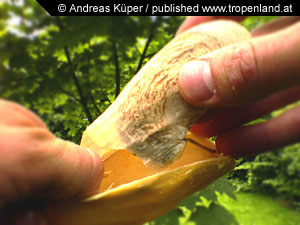 |
| 6th The paper-like skin should also be removed. | | 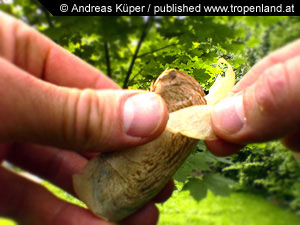 |
| 7th So, we see the seeds of liberated then. And the happy (because uninjured) Mango Mango friend ......( the way, was very tasty ......) | | 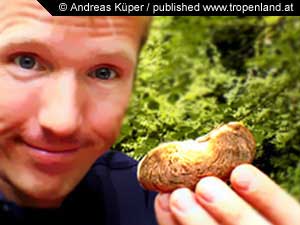 |
the imaged seeds I planted in cultivation soil (3cm deep). Plant the seeds as flat (horizontal), then the embryo has an easier start! It has been my experience that seed compost moldy not so easy and very fine crumbling and ensures good drainage.
Regards Andreas
Many thanks to Andrew and for your great instructions and photos.
| | |
substrate:
has proven to be a mixture of compost, sand, clay and peat. This loose, but nutrient-rich composition provides good and healthy growth.
| | |
casting:
especially in young plants, you must to ensure uniform moisture in the soil. Waterlogging says the mango but also not. After several years the plants are then hardened so far that they can survive short periods of drought.
| | |
fertilizing:
In winter, the mango is not fertilized, as they stop growing during this time. In the growth phase can then be fertilized every 1-2 weeks. Preferably one should use organic fertilizers.
 The mango tree bears oblong leaves, which are not shed in winter. | |
fruiting / harvesting:
The fruits vary in shape and color. They are spherical, oval to kidney shaped with a size of 8-20cm. The color is green, yellow, orange to red. Depending on the variety, the fruit pulp is traversed more or less of fiber and can be highly enriched with terpenes.
| |  The fruits of the mango tree, depending on the species look very different. The taste varies. |
fruit use:
contains vitamins to the mango, especially vitamin A and C. Because of their fresh and delicious flavor is one of the mango to one of the most popular tropical fruits. Use are found in fresh fruit, jams, canned fruit or juices. A poison that ingredient of the fruit skin, leaves and flowers, may cause allergic reactions in some people.
| |  is offered at the core of our mangoes are good for growing. |
warning:
The leaves, fruit peel and the flowers contain a poison that can cause allergic reactions in some people.
| | |
genus Info:
The genus includes about 300 species, with only M. indica plays an important commercial role.
| | |
| | |
Text: Dominik re

0 comments:
Post a Comment